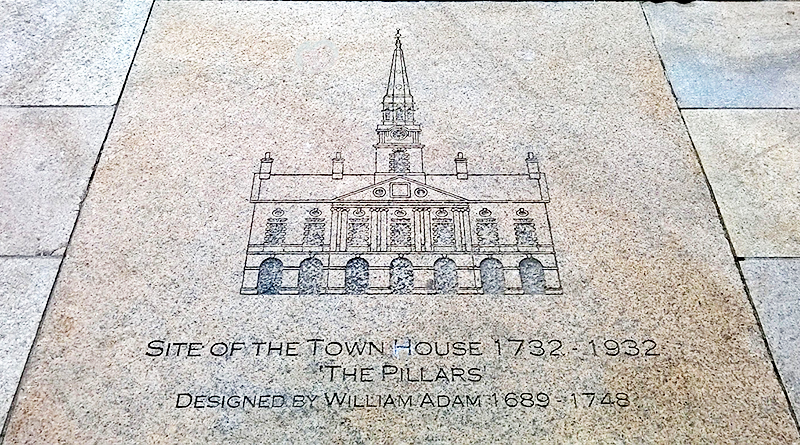In 1734 a new Town-House was completed on the former site of St Clement’s Church, which we know today as City Square. The building was a fairly grand structure, as was indicative of its multiple uses, with beautiful arched piazzas which looked out onto what is now Reform Street. It was locally referred to as ‘the pillars’. Markets were held under the safety of the piazzas in bad weather, and it was a place of general hustle and bustle. Atop the already-impressive building sat a spire which housed a bell, used for calling meetings or tolling proclamations. A fire in 1773 occurred on the roof of the building – the source of which was never determined – and it caused the frames holding the bell to crash into the rooms below it, causing considerable damage.
Shops took up the majority of the ground floor of the building, with the exception of one room for town officers to stay in, if they needed to. On the first floor were the offices of the Dundee Banking Company, who remained in the building for over 50 years, as well as an apothecary which was also said to have been well established and often-visited. Above all of this, on the second floor sat the Town Council’s Hall, described to be spacious and elegant, and also another hall (not as nice as the Town Council’s Hall) for the use of the Guildry for meetings and also for the Sheriff and Justices of the Peace to hold courts.
In 1788, a gang robbed the Dundee Banking Company by breaking into the Guildry Hall and ripping up the floor, allowing them access to the bank via its roof. Dropping into the bank from above, the gang made off with their loot in a daring night time robbery. Six people went to trial over the incident, and, despite only circumstantial evidence and the testimony of a man who was later sent to Botany Bay for forgery and subsequently hanged aboard the ship for trying to start a mutiny, 3 men were sentenced to death for the robbery. The guilt of those accused was something of a contentious issue at the time, with many people unconvinced. As robberies go, it was a fairly gutsy move by those involved – even more so because the Town Hall also housed the jail!
The main jail was on the third floor and was divided into 5 spacious rooms 24 foot long, 12 foot wide and 8 foot high. 2 rooms were kept for debtors, who were expected to provide their own bedding, candles and coal, as well as pay fourpence a day for running fees. The jail was said to be of a very high standard of cleanliness throughout. The ‘Iron House’, or jailer’s storeroom separated these 2 rooms at the front of the building from the 2 rooms at the back, which were for criminals. These rooms were strengthened, with the outer walls being fortified with iron netting, double sets of bars on the windows, and the doors braced with iron rods. Criminals were dealt with differently to those in debt, being allowed only a straw mattress and two rugs to sleep on. Above this part of the jail, in the attic space, a further 6 jail rooms were situated to account for overflow of prisoners, but by the 1800’s, it was used as the women’s prison. As with the male jails below, these were also kept to a very high standard.
Whilst hangings were uncommon, they still did occur from time to time. Murder and rape topped the list of offences, with 5 of the 6 recorded hangings listing this as the crime. The first hanging recorded was for housebreaking and theft, with the perpetrator being hung to make an example of him. Our list of hangings is here if you want to take a quick look. During the time of the Town Hall, hangings took place outside one of the east windows of the Guildry Hall, looking onto the High Street. John Watt, David Balfour and Mark Devlin all hung from the east side of the Town Hall. By the time the new police station was built at Ward Road/Lochee Road, executions were held there. Arthur Woods, Thomas Leith and William Bury all met their fate at the hangman’s noose, with Bury being the last man hung in Dundee.
Whilst the Town House jail was said to be fairly secure, it had been noted that the attic cells were slightly easier to break out of, hence it was offered up as the female jail. For anyone needing a bit of a special time-out, there was a frightfully dank and dark space in the basement for them, aptly named the “Thief’s Hole”. It wasn’t just people who were flung in there – sometimes property was held there…and once, even a tree!
For almost 200 years, the Town House sat in its prominent position before it was torn down to make way for City Square in the 1930’s. Attempts to save it, and even provide a new location for its re-erection proved to be fruitless, and it became yet another building Dundee lost to time.
References:
‘Dundee Delineated’, Printed by A Colville for self and Alex M Sandeman, 1822, pp 109 – 112
‘Undiscovered Dundee’, B King, Black & White Publishing, 2011, pp 1 – 5
‘Historical description of the town of Dundee’, C Mackie, Smith, Elder & Co., London, 1836 pp 66 – 67
Image of Town-House flagstone by Jim Glover
– DD Tours operates walking tours in Dundee city, covering dark local history such as wars, battles, murders, diseases, riots, disasters and executions. Walk with us for an unforgettable storytelling experience.
